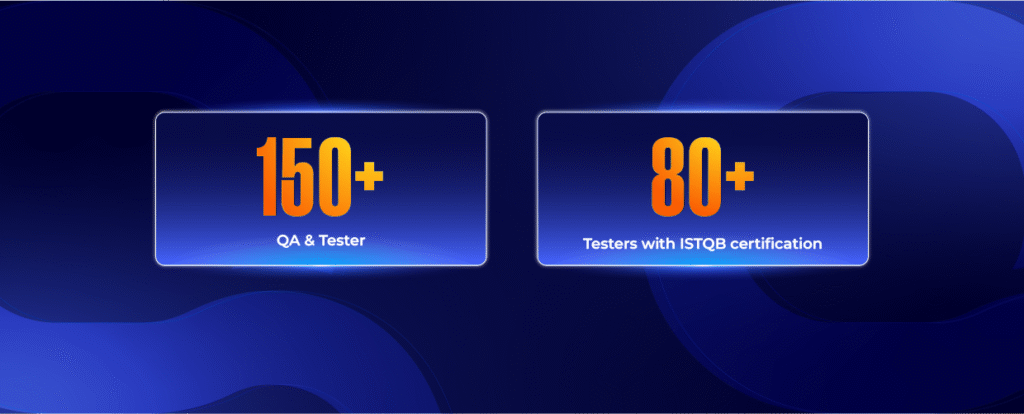
QA & Testing Services
Release with confidence. Our testing experts help you catch bugs early, reduce risk, and deliver software that works, every time.
From user drop-offs and broken features to delayed launches and reputational damage, undetected bugs can derail your entire roadmap. But building an in-house QA team is slow, expensive, and hard to scale.
NTQ Europe helps you test smarter and ship better with a flexible QA & testing service designed to support modern engineering teams. Whether you need help with test case design, manual execution, automation scripts, or continuous integration. We plug in where you need us most, and help you ship with confidence.
Our QA specialists perform structured manual testing across platforms and devices, ensuring every use case, edge case, and regression scenario is properly covered. Ideal for early-stage products, UX-heavy apps, and dynamic feature updates where human intuition still matters most.
We help you accelerate your release cycles and improve test coverage by building scalable automation frameworks using tools like Selenium, Cypress, or Playwright. Whether you’re looking to implement CI/CD pipelines or reduce repetitive regression testing, our test engineers make automation practical and maintainable.
Identify security vulnerabilities before attackers do. Our penetration testing service simulates real-world cyberattacks to uncover weaknesses across your application, APIs, and infrastructure. You’ll get detailed reports, risk prioritization, and actionable recommendations. Everything will help you stay compliant and secure.

No two products require the same testing strategy. That’s why our QA team doesn’t just execute, we advise, adapt, and align with your goals. Whether you’re validating a new MVP, hardening a mature system, or scaling CI/CD pipelines, we help you choose the right mix of tools, techniques, and test coverage to match your stage of growth.
Ensuring quality and reliability through meticulous QA and testing, delivering flawless results every time
| Criteria | NTQ Europe Integrated QA Outsourcing | Traditional QA Outsourcing | In-house QA Team |
| Collaboration & Transparency | Embedded into your team, aligned with your process | Operates independently, limited visibility | Full internal control |
| Flexibility | High – adapts to tools, scope, and team structure | Low – rigid process and scope | Medium – process aligned but resource-bound |
| Onboarding Speed | Fast – pre-vetted talent, ready to join | Moderate – depends on vendor setup | Slow – requires full recruitment cycle |
| QA Strategy Support | Included – proactive guidance and test optimization | Rare – limited to execution only | Internal responsibility |
| Process Integration | Aligned with Agile, CI/CD, DevOps | Often siloed or waterfall-based | Fully integrated |
| Cost Structure | Balanced – scalable without overhead | Lower short-term, may lack flexibility | High fixed costs |
| Best For | Product teams needing speed + visibility | Fixed-scope, short-term QA needs | Stable teams with long-term QA investment |



Vietnam’s tech sector isn’t just known for strong development teams, it’s also gaining recognition for quality assurance expertise. With a growing talent pool of over 500,000 IT professionals, including a fast-expanding community of certified QA engineers and test automation specialists, Vietnam is quickly becoming a trusted destination for global QA needs.
Vietnamese QA professionals are trained in both manual and automated testing methodologies, familiar with Agile, and experienced in tools like Selenium, Cypress, and TestRail. More importantly, they bring a strong work ethic, process discipline, and attention to detail that matches the quality expectations of European and global clients.

Functional testing verifies that your application works as expected – covering use cases, inputs/outputs, and business rules. It answers the question: “Does this feature do what it’s supposed to?”. Non-functional testing focuses on how your system performs under real-world conditions: speed, scalability, security, and reliability. This includes performance testing, load testing, penetration testing, and more – helping ensure your product meets quality beyond just functionality.
Absolutely. We often work as an independent QA partner for teams with in-house or third-party development. We can align with your processes, tools, and release cycles to ensure seamless testing integration.
Our QA leads create structured test plans, define coverage criteria based on user journeys, and track metrics like defect density, test case pass rate, and regression success. We also regularly review test effectiveness and adapt strategies to evolving product needs.
Our team is proficient with tools like Selenium, Cypress, Postman, JMeter, TestRail, Jira, and more. It all depends on your specific tech stack and QA goals. We help you choose the right tooling based on what fits your workflow best.
Yes. Our engagement model is designed to be flexible. You can start with a small QA setup and expand (or contract) based on your release roadmap, without long-term commitments or operational overhead.